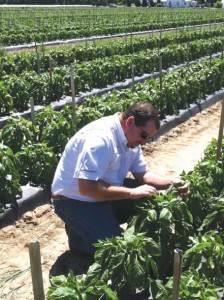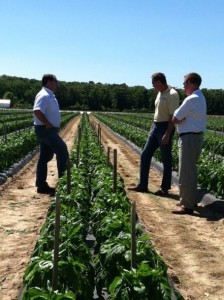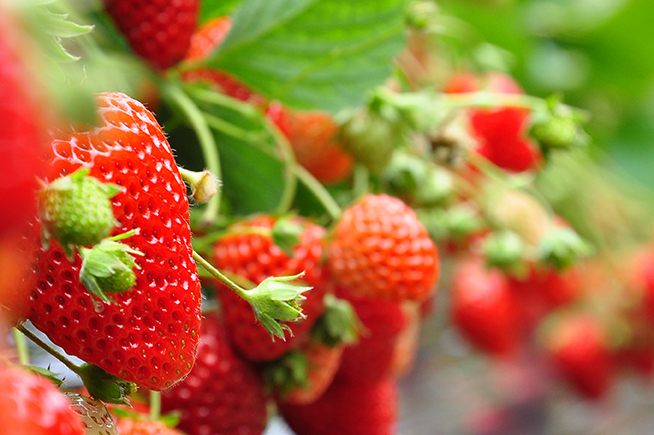Locally Grown The Lipman Way
The program is called Lipman Local, and with it, Lipman — based in Immokalee, FL — is able to supply locally grown produce to grocery chains, food service operators, and other outlets around the country.
Specifically, Lipman, North America’s largest field tomato grower, partners with small- to medium-size farmers in a number of U.S. states to sell virtually all types of fruits and vegetables in local markets. In return for sourcing the local produce, Lipman helps its partner growers raise the level of their own operations with education, advice, and cooperation in such areas as food safety, technology use, purchasing power, and sales and marketing.

Scott Rush of Florida-based Lipman helps about 35 partner growers from different states for the Lipman Local program. Photo courtesy of Lipman
Timing Local Produce
Now in its fifth year, the program is in what program director Scott Rush refers to as “crunch time.” This is the time of year when people think local, he says.
“People crave Tennessee tomatoes or Jersey tomatoes, or beans out of the mountains of North Carolina. There are different areas [of the country] where people get really excited about local produce, and it is at this time of year that they are looking for these products,” Rush explains.
In addition to being the director of Lipman Local, Rush also is the general manager of Lipman Farm #2 in Estero, FL. A grower for the company for 21 years, Rush says Lipman approached him to get involved in the program.
“It makes sense for the person who heads up the program to be a farmer,” he says.
Rush works with about 35 growers who hail mostly from the East Coast heading as far south as Alabama, but he says the plan is to expand the program west to include more growers. In fact, last month he visited growers in Tennessee, Maryland, Pennsylvania, and Mississippi regarding partnerships with Lipman.
He adds that farm size plays no role in the decision to work with a particular grower. According to Rush, the range is between 40- and 1,000-acre operations.
“It is a very diverse program,” he explains. “We work with Amish and Mennonite growers who have packing houses powered by horses. On the other end of the spectrum, we work with farmers that use the gamut of technology that exists — and everybody in between.”
Get Involved
Rush says when an operation contacts Lipman about participating in the program, the first order of business is to determine if the partnership meets the needs of both the small farm and Lipman. If it will be a fit, Lipman checks if it can set up a program in that area.
It’s not always a grower approaching Lipman regarding a partnership, either. Rush says sometimes Lipman seeks out partners, depending on where the operation needs to source local produce for customers. “It can work either way,” he adds.
After it’s determined that a partnership will be a good fit for both parties, what is sourced from the partnering operation varies as well. For example, Rush says he works with a grower in Kentucky who grows about 150 acres of specialty peppers, okra, and pole beans. Lipman sources about half of what the Kentucky farm produces for its local program, selling some of the produce under the Lipman brand. The other half of the produce is already spoken for, as the Kentucky grower sells it to area restaurants.
“The benefits [for the Kentucky grower] of working with me are that I can teach him how to grow crops he is not necessarily used to, and try to expand his business,” Rush explains. “I get the benefit of getting my customers the produce they need, and we are able to get it locally sourced.”
Areas Of Assistance

Scott Rush (left) of Lipman helps helps partner growers raise the level of their own operations with education, advice, and cooperation in such areas as food safety, technology use, purchasing power, and sales and marketing.
Photo courtesy of Lipman
Lipman offers its grower partners help in a number of areas. According to Rush, the biggest area is in the food safety category. Lipman has a food safety staff that travels around the country, assisting growers. Specifically, they help growers understand which certifications are needed, depending on their size and area, and they provide the resources to ensure the audits go according to plan.
“By partnering with us, growers are brought to Florida where we have a large winter operation, and they will spend about two to four days with me on my farm so they can see what we do with GAPs, inventory mapping, trialing, etc. A lot of times smaller growers can’t spend money on fumigants, herbicides, and new technology because of the expense. It is our size, however, that allows us to trial things in advance. For example, we were way out ahead of the methyl bromide phase out. If people partner with us, we can share some of that technology, which will help them jump that learning curve quite a bit.”
Lipman’s size also helps with purchasing power. “A grower trying to produce on 250 acres doesn’t have the greatest bargaining power,” Rush says. “If he jumps on board with us, he can get into that stream of buying. A lot of the regional growing practices are completely different, but many of the commodities that go into growing those crops are the same.”
Size matters when it comes to sales and marketing, too. “It is expensive to have a big sales force to market your produce around the country,” he explains. “With us growing 52 weeks a year, we are also planting and harvesting 52 weeks a year somewhere in the country. If [a partner] is able to get involved, we can offer access to customers that they may not be able to get a hold of on their own.”
Putting In The Time
The amount of time Rush spends with grower partners depends on their specific needs.
“Some of the [growers] don’t need a lot of my time; they are great at what they do and will just stop by my farm a few times during the summer, and I’ll spend time with them as needed. I’ve got other growers, however, who have asked me to spend a week with them this summer during the peak of their operation,” he says.
“There is no set ‘This is the program, this works, this is what it is.’ All parts of the program have to be tailored to individual needs. Some guys need or want more help, and some don’t,” he explains.
From his experience, Rush says he has learned as much he has taught. “I have seen people do things that I would have never thought of doing, and I’m completely shocked and awed by it. Then those growers come here and see things we do that they would have never thought of. So I would say it is a win-win on both sides.”
Rush predicts the program will continue to grow. “Local produce is just better produce because it doesn’t have as many miles logged on to it. It gets to the customer fresher, and people just feel better about eating local produce,” he says. “It makes sense to go local.”
Little Savings Add Up
Scott Rush, director of the Lipman Local Program, a part of Florida-based Lipman, says in spite of the size and location differences among the growers he works with to source local produce, there are two leading concerns for all: costs and labor.
Lipman partners with 35 growers for the local program. Rush says they are able to help these growers shave the margins, but he says because the margins are so tight in farming now, finding someone a way to save 50% simply won’t happen.
“If we can shave off 3% to 5% here and there with labor reductions, technology or packing practices, that will be a big positive,” he says. “The biggest area of concern, however, is to lower labor costs.”










